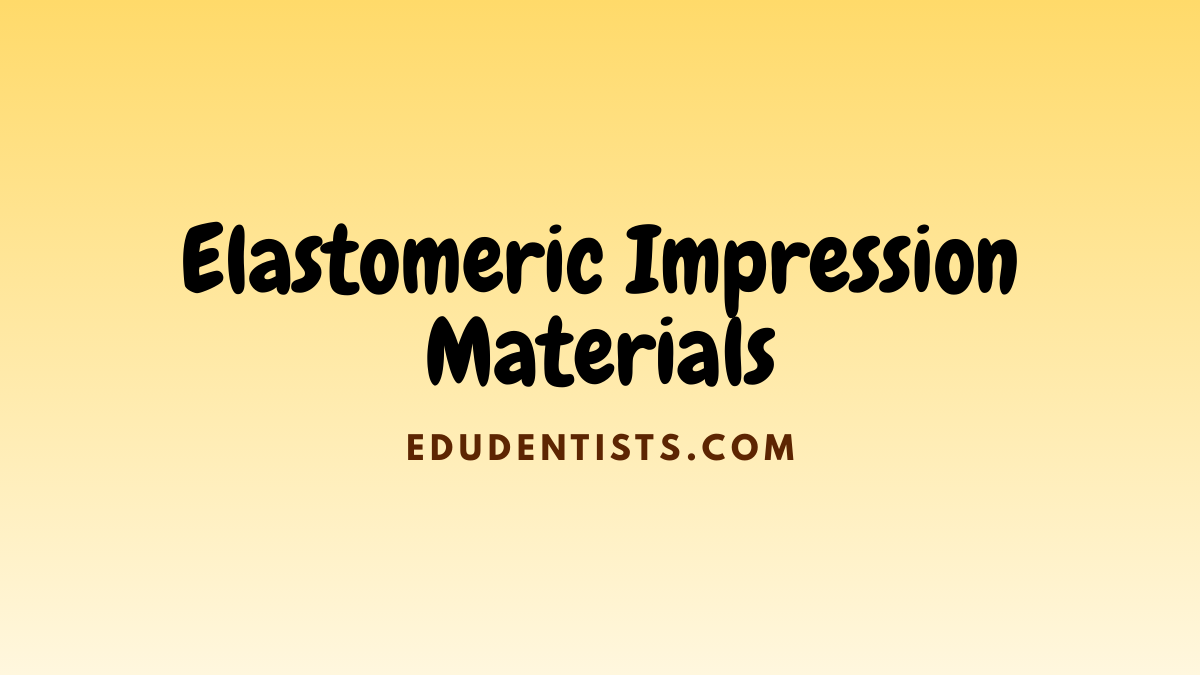
Elastomeric Impression Materials
Elastomeric Impression Materials
Properties, Types, and Clinical Significance
Elastomeric impression materials are synthetic, rubber-like substances widely used in fixed and removable prosthodontics due to their high elasticity, excellent recovery, and dimensional accuracy. They are designed to stretch during removal from undercut areas and return to their original shape without distortion.
These materials are supplied as two-part systems (base and catalyst) and are chemically cross-linked during setting, forming a stable, resilient structure. Common types include polysulfides, silicones (condensation and addition), and polyethers.
1. Polysulfide Impression Materials
Composition & Setting:
Polysulfide materials contain a base paste (polysulfide polymer, filler, plasticizer, sulfur) and a catalyst paste (lead dioxide, retarder, plasticizer). When mixed, a chemical reaction forms a flexible, cross-linked network.
Key Features:
- Long working time and good tear resistance.
- Set is affected by temperature and humidity.
- Water is released as a by-product, leading to dimensional changes over time.
- Brown color due to lead dioxide.
- Must be used with matching components from the manufacturer.
Clinical Use:
Suitable for complete denture impressions and areas with moderate undercuts, though dimensional stability is limited if casts are delayed.
2. Condensation Silicone
Composition & Setting:
A two-part system involving a base paste (hydroxyl-terminated polydimethylsiloxane) and catalyst (alkyl silicates and stannous octoate). Cross-linking occurs with ethyl alcohol as a by-product, contributing to shrinkage and limited dimensional stability.
Key Features:
- Available in multiple viscosities (including putty-wash techniques).
- Requires prompt pouring of casts.
- Moderate detail reproduction.
- Hydrophobic nature unless modified with surfactants.
Clinical Use:
Used for crown and bridge work, often with a putty-wash technique.
3. Addition Silicone (Polyvinyl Siloxane / PVS / VPS)
Composition & Setting:
Based on addition polymerization between vinyl-terminated silicones and hydride-functional silicones, using platinum as a catalyst. No by-products are released under ideal conditions.
Key Features:
- High dimensional stability and excellent accuracy.
- Risk of hydrogen gas release, which can cause voids in stone casts if poured too soon. Palladium may be added to absorb this gas.
- Hydrophobic by nature, but modern versions are treated with surfactants for improved wettability.
- Sensitive to sulfur contamination (e.g., from latex gloves), which can inhibit polymerization.
Clinical Use:
- Ideal for precise impressions in fixed prosthodontics.
- Medium-body versions are used as alginate substitutes for diagnostic models.
4. Polyether Impression Materials
Polyethers offer excellent hydrophilicity and accuracy, especially in moist environments.
Type 1: Traditional Polyether
- Based on ring-opening polymerization of aziridine groups.
- Supplied as base and catalyst pastes.
- Offers high flow and wettability; can be stiff after setting.
Type 2: Hybrid Polyether
- Involves acid-catalyzed condensation with alcohol by-products.
- Shares similar mechanical behavior with traditional polyethers.
- Considered a hybrid between polyether and silicone chemistries.
Clinical Use:
- Suitable for crown, bridge, and implant impressions, particularly when soft tissue detail and moisture tolerance are critical.
Summary Table
| Type | Elasticity | Hydrophilicity | By-Product | Dimensional Stability | Clinical Use |
|---|---|---|---|---|---|
| Polysulfide | High | Low | Yes (Water) | Moderate | Denture impressions, undercuts |
| Condensation Silicone | Moderate | Low–Moderate | Yes (Alcohol) | Low–Moderate | Crown/bridge (putty-wash) |
| Addition Silicone (PVS) | High | Modified (Hydrophilic surfactants) | Minimal (Hydrogen) | Excellent | Precision impressions, diagnostic models |
| Polyether | High | High | Type-dependent | Excellent | Moist areas, implants, crowns/bridge |
Final Notes for Clinical Practice
- Material choice depends on tissue condition, presence of moisture, need for accuracy, and time constraints.
- Modern elastomers allow for highly accurate impressions, but require careful handling (e.g., avoiding latex interference in PVS).
- Storage and pouring time should always follow manufacturer instructions to preserve dimensional accuracy.